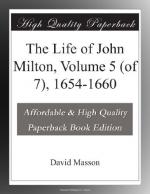Far more than the mere stopping of his pamphlet was involved for Milton in the events of that fortnight. He could construe them no otherwise than as the breaking down of the inner rampart that defended the Commonwealth against Charles Stuart. The Roasting of the Rump in London was but a rough popular metaphor for “Down with the Republic”; and, had the tumult of that night extended from the City to Westminster and the breaking of the windows of “fanatics” become general, Milton’s would not have escaped. Then, in the course of the negotiations with Monk through the fatal fortnight, had not the Rump itself quailed? Had they not offered to cancel the solemn Abjuration Oath, alike for the Councillors of State and for future members of Parliament, and to substitute only a general engagement to be faithful to the Commonwealth, without King, Single Person, or House of Lords? Hardly anywhere now did there seem to be that stern, bold, uncompromising opposition to Royalty which would register itself, as Milton wanted, in an oath before God and man, but only that feebler Republicanism which would pledge itself with the understood reservation of “circumstances permitting.” But worst of all was the crowning fact that the Secluded Members had been restored. By that one stroke of Monk’s all that had happened since the Commonwealth had been set up was put in question, and the power was given back into the hands of the very men who had protested and struggled against the setting up of the Commonwealth eleven years ago. How would these act? It might be hoped perhaps that some of the more prudent among them, having regard to the lapse of time and the change of circumstances, might not think it their duty to be as vehemently Royalist now as they had been in 1648, and also perhaps that the power of Monk, if Monk himself remained true, might restrain the rest. But would Monk remain true, or would his power avail long in restraining a Parliament the majority of which were Presbyterians and Royalists? Not to speak of the varied ability and subtlety of such of the new Parliamentary chiefs as Annesley, Sir William Waller, Denzil Holles, Ashley Cooper, and Harbottle Grimstone, what was to be expected from the remorseless obstinacy, the rhinoceros persistency, of such a Presbyterian as Prynne? How often had Milton jeered at Prynne and the margins of his endless pamphlets! It might be of some consequence to him now to remember that he had done so, and had therefore this virtual Attorney-General of the Secluded for his personal enemy. Altogether, Milton’s despondency had never yet been so deep as it must have been at this beginning of the last phase of the long English Revolution, represented in the Parliament of the Secluded Members and in Monk’s accompanying Dictatorship.
CHAPTER II.
Third Section.
MILTON THROUGH MONK’S DICTATORSHIP. FEB. 1659-60—MAY 1660.




